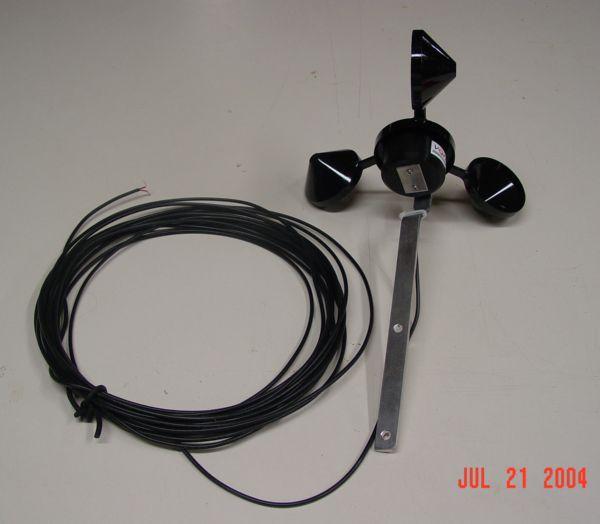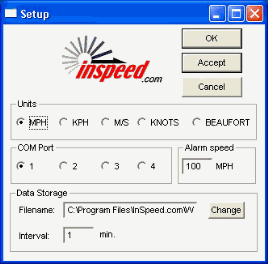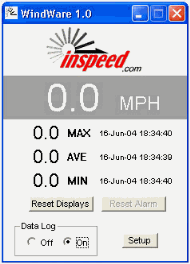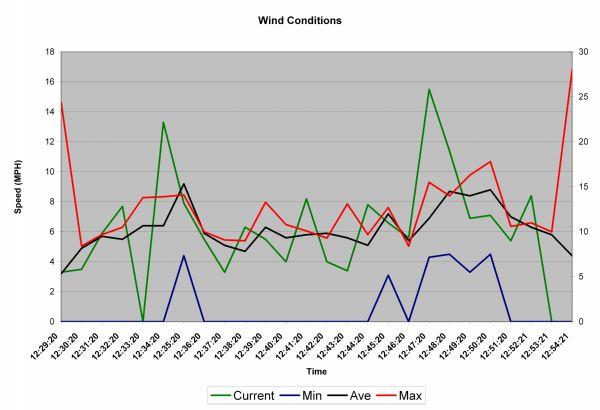| Manufacturer: | Inspeed |
One of the things that can plague a launch is our friend Mr. Wind. We all know there is an upper limit to how much wind we should launch in, but how do you tell if you have exceeded it? I found an inexpensive anemometer by a small firm called Inspeed. The device is based on a speedometer for racing bicycles and comes in a number of configurations.
- Hand held with integrated display
- Pole mounted with a remote display
- A magnetic mount for automobiles – designed, I think for people who chase tornadoes…And they say rocketeers are crazy…
There is also a data capture and analysis package called Windware.
I purchased the pole mount anemometer without the display and a copy of Windware..
The actual device is rather compact and comes with a tool to hook it up to a serial port on your PC. I plan to use mine with a laptop at launches.
I mounted the anemometer on a 6’ fiberglass shaft and terminated the cables so the serial connector could be disconnected from the main lead by way of a 1/8" phone plug.

The software is compatible with Microsoft Windows 2000 and XP only. Setting the software up is a breeze; you download the small install package and load it up. Connect the serial cable, configure the port, set the speed units and reap the wind.


Setup Screen Real time Display
One really nice feature is the ability to log data. You can set the software to capture the speed as frequently as every one minute. The output format is a .CSV or comma separated ASCII file that is easily imported into a spreadsheet.
|
**** Logging started on 31-Jul-04 12:28:20 **** |
|||||
|
Units: MPH |
|||||
|
Date |
Time |
Current |
Min |
Max |
Ave |
|
31-Jul-04 |
12:29:20 |
3.3 |
0 |
24.4 |
3.2 |
|
31-Jul-04 |
12:30:20 |
3.5 |
0 |
8.4 |
4.9 |
|
31-Jul-04 |
12:31:20 |
5.9 |
0 |
9.7 |
5.7 |
|
31-Jul-04 |
12:32:20 |
7.7 |
0 |
10.5 |
5.5 |
|
31-Jul-04 |
12:33:20 |
0 |
0 |
13.8 |
6.4 |
|
31-Jul-04 |
12:34:20 |
13.3 |
0 |
13.9 |
6.4 |
|
31-Jul-04 |
12:35:20 |
7.9 |
4.4 |
14.1 |
9.2 |
|
31-Jul-04 |
12:36:20 |
5.5 |
0 |
10 |
5.9 |
|
31-Jul-04 |
12:37:20 |
3.3 |
0 |
9.1 |
5.1 |
|
31-Jul-04 |
12:38:20 |
6.3 |
0 |
9 |
4.7 |
|
31-Jul-04 |
12:39:20 |
5.5 |
0 |
13.3 |
6.3 |
|
31-Jul-04 |
12:40:20 |
4 |
0 |
10.8 |
5.6 |
|
31-Jul-04 |
12:41:20 |
8.2 |
0 |
10.1 |
5.8 |
|
31-Jul-04 |
12:42:20 |
4 |
0 |
9.3 |
5.9 |
|
31-Jul-04 |
12:43:20 |
3.4 |
0 |
13.1 |
5.6 |
|
31-Jul-04 |
12:44:20 |
7.8 |
0 |
9.7 |
5.1 |
|
31-Jul-04 |
12:45:20 |
6.6 |
3.1 |
12.7 |
7.2 |
|
31-Jul-04 |
12:46:20 |
5.6 |
0 |
8.4 |
5.4 |
|
31-Jul-04 |
12:47:20 |
15.5 |
4.3 |
15.5 |
6.9 |
|
31-Jul-04 |
12:48:20 |
11.4 |
4.5 |
14 |
8.7 |
|
31-Jul-04 |
12:49:20 |
6.9 |
3.3 |
16.3 |
8.4 |
|
31-Jul-04 |
12:50:20 |
7.1 |
4.5 |
17.8 |
8.8 |
|
31-Jul-04 |
12:51:20 |
5.4 |
0 |
10.6 |
7 |
|
31-Jul-04 |
12:52:21 |
8.4 |
0 |
11 |
6.3 |
|
31-Jul-04 |
12:53:21 |
0 |
0 |
10 |
5.8 |
|
31-Jul-04 |
12:54:21 |
0 |
0 |
28 |
4.4 |
Sample data from Microsoft Excel

Graph from the above data
Another feature is that there is a switched output you can hook to an external alarm that will announce when a maximum speed is reached. This would be a nice feature for the RSO/LCO to have available. I’m considering designing this into my launch control panel. If wind exceeds a certain point, the panel is disabled.
This is a neat little tool that could easily find its way into many a club’s range equipment.
Overall Rating: 5 out of 5
 |
 |
Sponsored Ads
 |
 |












D.S. (November 2, 2004)